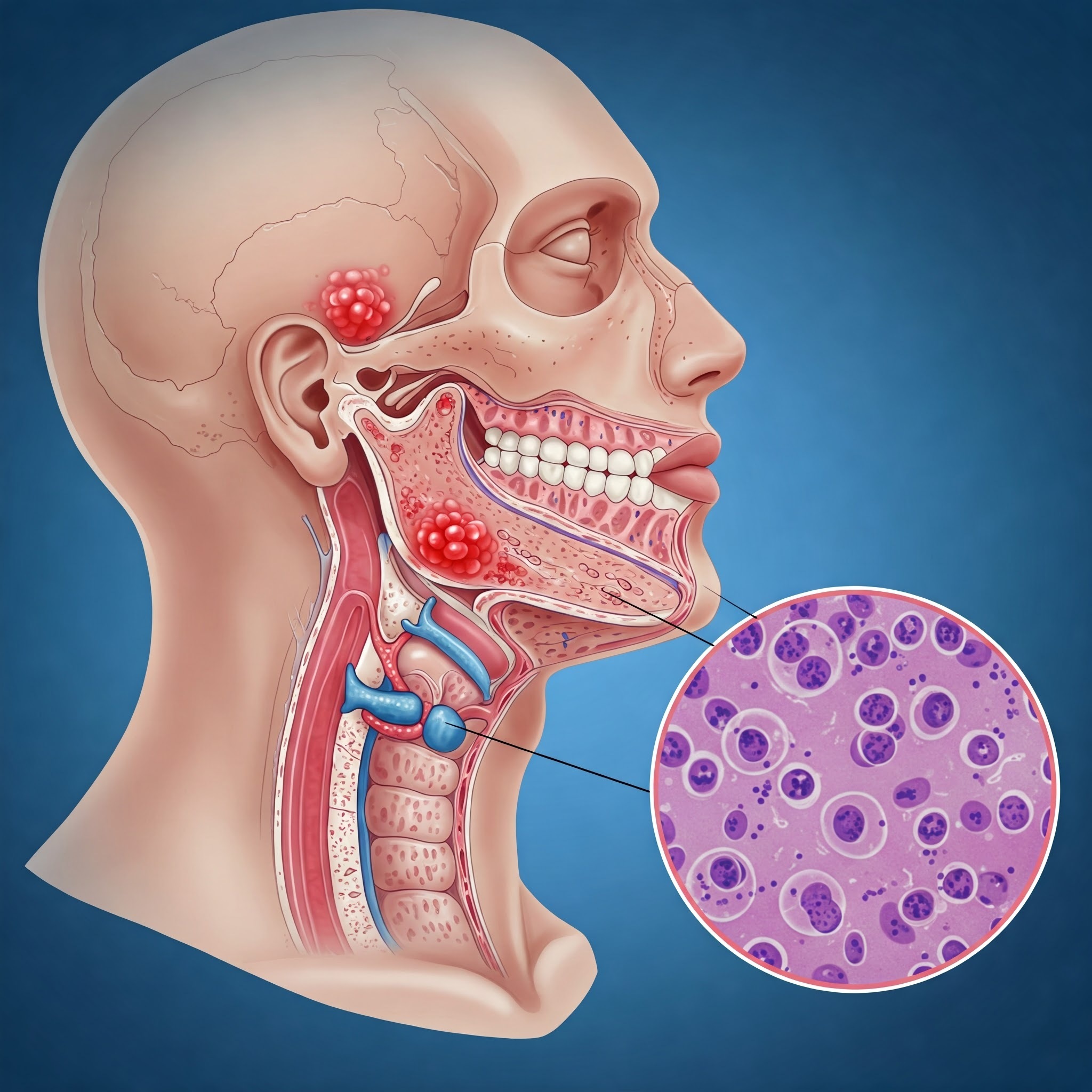Protect your health with early head and neck cancer detection
Expert support and advanced care for long-term wellness
Recognizing symptoms such as persistent hoarseness, difficulty swallowing, non-healing mouth sores, or swelling in the neck can be crucial for early diagnosis. Our clinic is equipped with cutting-edge diagnostic technology that allows for precise evaluation of the mouth, throat, voice box, nasal passages, and related areas—enabling us to detect cancer in its earliest and most treatable stages.
We treat a wide range of head and neck cancers, including those of the oral cavity, pharynx, larynx, salivary glands, and nasal cavity. Our personalized care plans are built around each patient’s unique condition, addressing common risk factors such as tobacco and alcohol use, HPV infection, and environmental exposures. From minimally invasive surgery and radiation therapy to chemotherapy and reconstructive techniques, we offer comprehensive treatment options tailored to your needs.
At Neo-Woman’s, patient empowerment is a core value. We focus on education, preventive screenings, and follow-up care to ensure that patients stay informed and supported throughout their health journey. Our multidisciplinary approach emphasizes not just treatment, but also recovery of function and quality of life.
Take charge of your health today—schedule a screening with Neo-Woman’s Head & Neck Cancer Clinic and receive expert care guided by compassion, precision, and a commitment to your well-being.


Neo-woman head & neck cancer clinic: comprehensive care for your health
At Neo-Woman Head & Neck Cancer Clinic, our team of dedicated specialists offers complete support through every stage of head and neck cancer diagnosis, treatment, and recovery. From expert consultations to advanced diagnostics, we provide personalized care tailored to each individual’s condition. Identifying early signs—such as persistent hoarseness, difficulty swallowing, chronic sore throat, or lumps in the neck—is vital for timely detection. Using state-of-the-art imaging and diagnostic technologies, our clinic ensures accurate evaluation and prompt, effective treatment planning.
Understanding the root causes of head and neck cancers—including tobacco use, heavy alcohol intake, HPV infection, and environmental exposures—plays a key role in both prevention and early intervention. Our specialists offer in-depth guidance on the different types of head and neck cancers, such as cancers of the throat, voice box, nasal cavity, sinuses, and salivary glands, helping patients make informed decisions about their health.
Each patient receives a customized treatment plan based on their specific diagnosis, stage of cancer, and overall health needs. Whether it involves minimally invasive surgery, radiation therapy, chemotherapy, or reconstructive techniques, our multidisciplinary team works together to provide the most effective and compassionate care.
At Neo-Woman’s, we believe in a holistic approach that integrates medical excellence with emotional and rehabilitative support. We emphasize patient education, encouraging awareness of the importance of early detection and regular screenings to significantly improve survival rates and long-term outcomes.
With Neo-Woman’s Head & Neck Cancer Clinic, you’re never alone in your journey. Trust our expert care to guide you toward recovery, restoration, and lasting wellness.
- Understanding head and neck cancer
Head and neck cancer refers to a group of biologically similar cancers that arise in the tissues and organs of the head and neck region. These include the oral cavity, pharynx (throat), larynx (voice box), nasal cavity, sinuses, and salivary glands. Though diverse in location, these cancers often share common risk factors and treatment approaches. Early symptoms may include a persistent sore throat, hoarseness, difficulty swallowing, or a lump in the neck.
Here are some of the check up and health screenings that you should get done:
- Pelvic Exam
- Pap Smear (Cervical Cancer Screening)
- Breast Exam
- Blood Pressure Measurement
- Cholesterol Screening
- Bone Density Scan (DXA)
- Blood Sugar Test (Glucose Screening)
- Thyroid Function Tests
- Blood Count (Complete Blood Count, CBC)
* The specific exams and screenings recommended can vary based on a woman’s age, family history, personal health history, and risk factors. It’s essential to discuss your individual healthcare needs and screening schedule with your healthcare provider.
- Common types and their locations
The most prevalent types of head and neck cancer include oral cavity cancer (affecting the lips, tongue, gums, and roof or floor of the mouth), pharyngeal cancer (impacting the nasopharynx, oropharynx, or hypopharynx), and laryngeal cancer (originating in the voice box). Other less common forms include nasal cavity and sinus cancers, as well as salivary gland tumors. Each type presents unique challenges based on its location and potential to impact breathing, speaking, or eating.
- Risk factors and causes
Several environmental and lifestyle factors contribute to the development of head and neck cancers. The leading causes include tobacco use (both smoking and chewing), heavy alcohol consumption, and human papillomavirus (HPV) infection, particularly in oropharyngeal cancer. Poor oral hygiene, prolonged sun exposure (for lip cancers), and exposure to industrial chemicals can also raise the risk. Understanding these factors is crucial for prevention and early detection.
- Advanced surgical and treatment options
Treatment for head and neck cancer often involves a multidisciplinary approach, with surgery playing a central role. Modern techniques like Transoral Robotic Surgery (TORS) and laser excision allow for minimally invasive tumor removal with faster recovery. In more complex cases, microvascular reconstructive surgery helps restore appearance and function after extensive tissue removal. Surgery may be combined with radiation therapy, chemotherapy, targeted therapies, or immunotherapy depending on the cancer’s stage and location.
- Comprehensive care and recovery
Beyond eliminating the tumor, a core focus of head and neck cancer care is on preserving the patient’s quality of life. Reconstructive surgery, speech and swallowing therapy, and nutritional support play vital roles in recovery. Long-term follow-up is essential to monitor for recurrence and manage any side effects of treatment. A holistic care plan—led by surgeons, oncologists, speech therapists, and nutritionists—ensures that patients regain both physical function and emotional well-being.

Frequently asked questions
What are the early signs of head and neck cancer?
Early symptoms may include a persistent sore throat, difficulty swallowing, hoarseness, unexplained weight loss, a lump or swelling in the neck, or a non-healing sore in the mouth or throat. Some may also experience ear pain or changes in voice.
Who is at risk of developing head and neck cancer?
Major risk factors include tobacco use (smoking and smokeless), excessive alcohol consumption, human papillomavirus (HPV) infection, poor oral hygiene, and prolonged exposure to certain industrial chemicals or environmental pollutants. Individuals over the age of 40 are more commonly affected.
How is head and neck cancer diagnosed?
Diagnosis typically involves a thorough physical examination, endoscopy, imaging tests like CT scans, MRIs, or PET scans, and a biopsy to confirm the presence of cancerous cells. Early detection is critical for effective treatment.
What are the treatment options for head and neck cancer?
Treatment depends on the type, location, and stage of the cancer. It may include surgery to remove the tumor, radiation therapy, chemotherapy, immunotherapy, or a combination of these. Reconstructive surgery and rehabilitation may also be part of the care plan.
How does the survival rate vary for head and neck cancer?
Survival rates are influenced by factors such as the cancer’s location, stage at diagnosis, patient’s overall health, and how early the cancer is detected. Generally, early-stage head and neck cancers have a higher survival rate compared to those diagnosed at a later stage.
